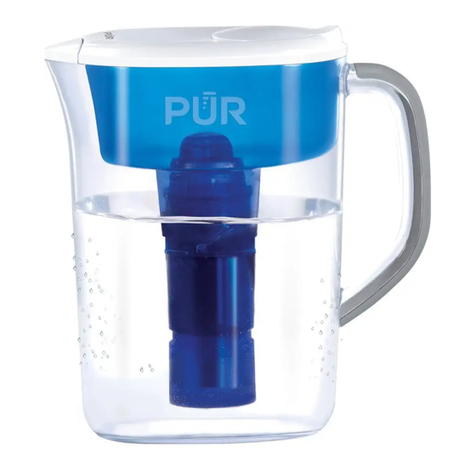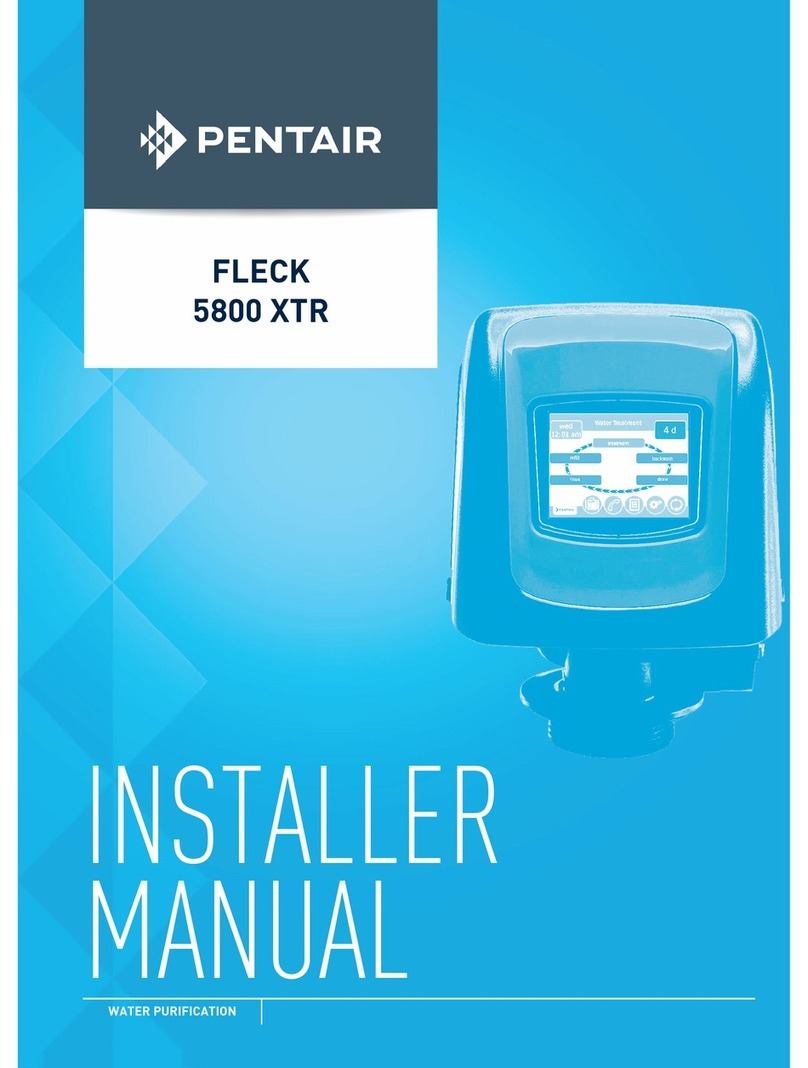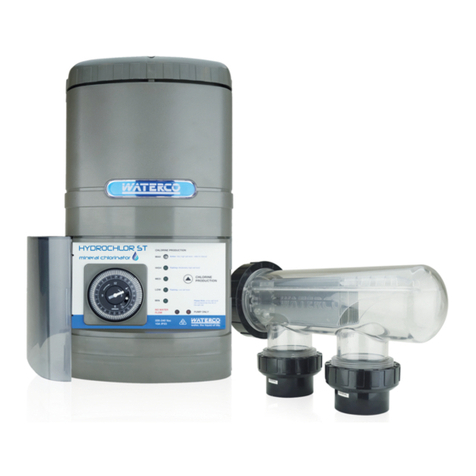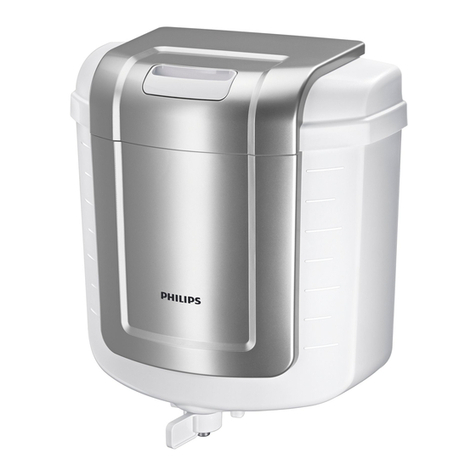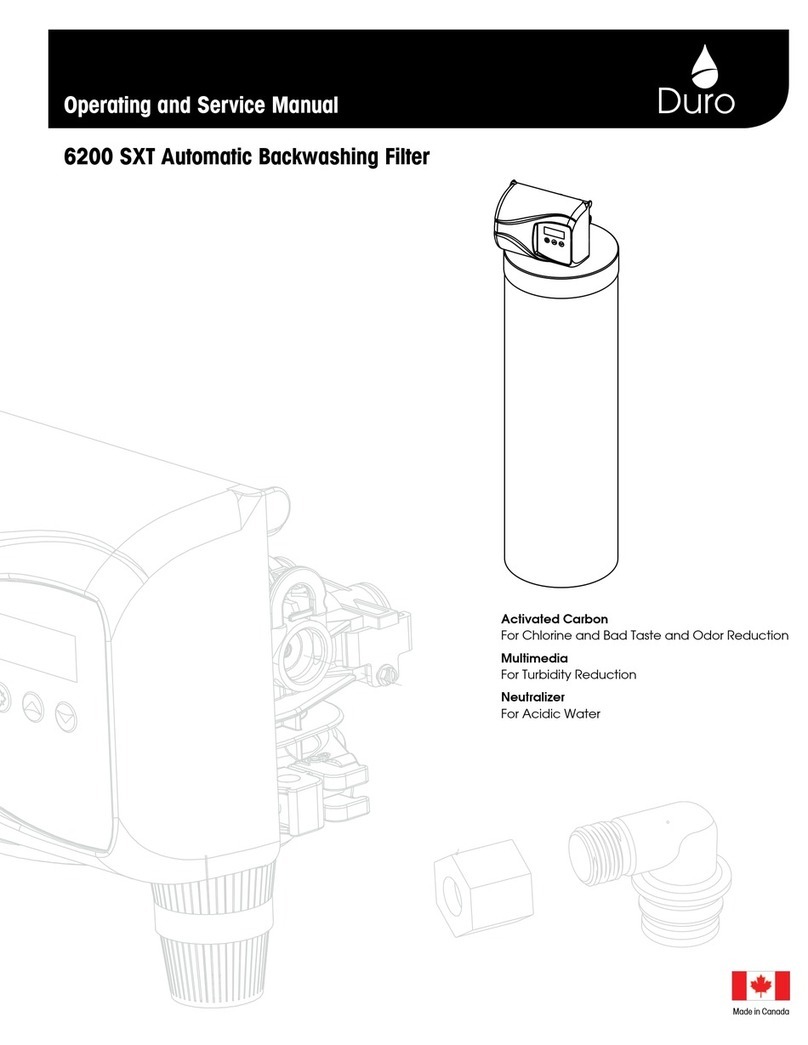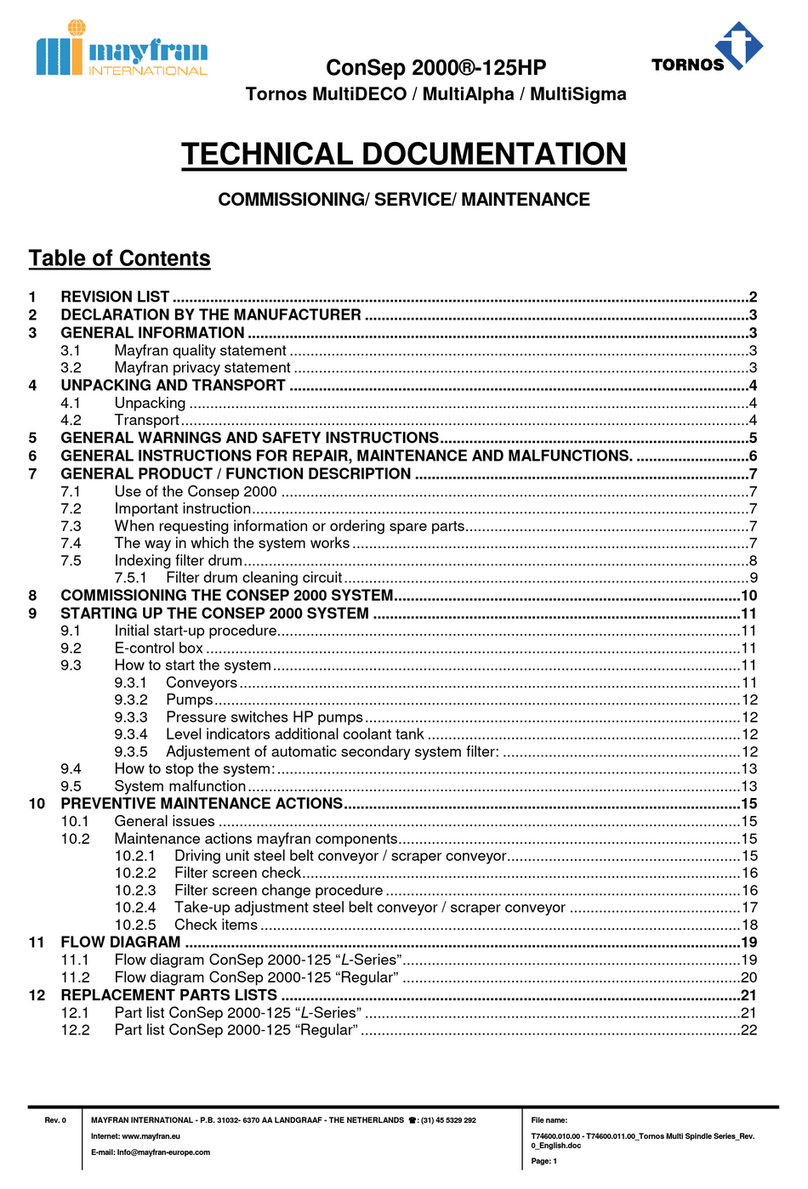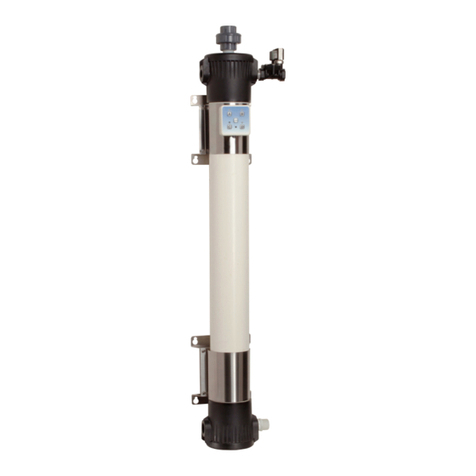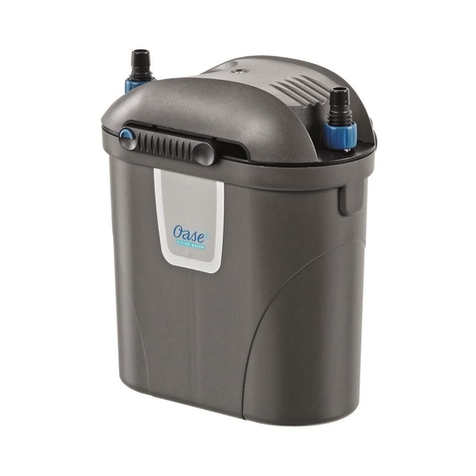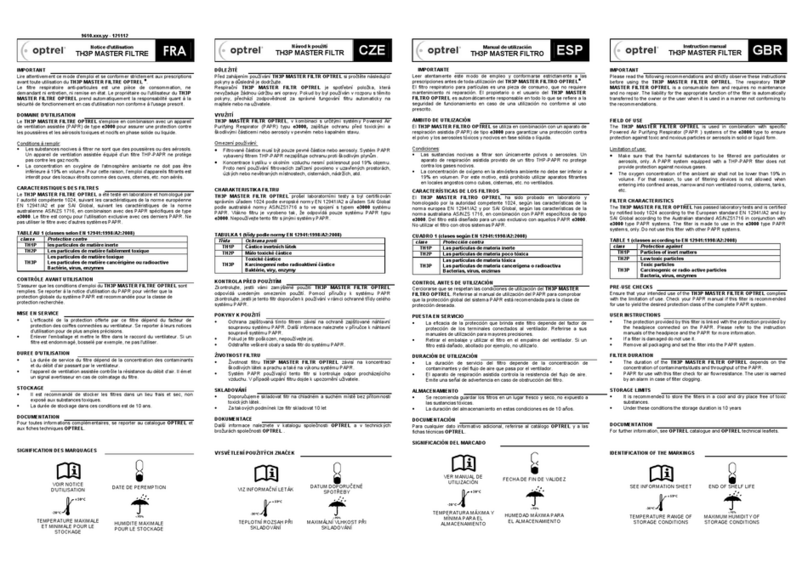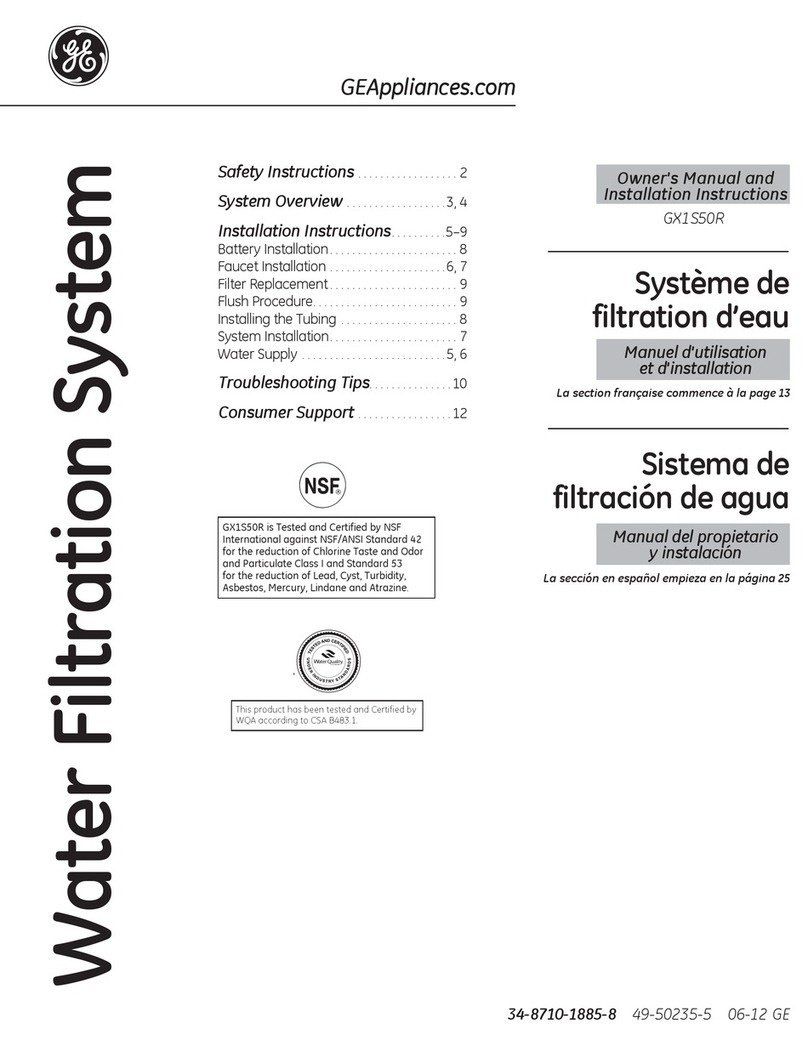Imbrium Stormceptor EF User manual

EF
Owner's Manual

2Stormceptor ® EF Owner's Manual
STORMCEPTOR®EF IS PATENT-PENDING.
TABLE OF CONTENTS
• STORMCEPTOR EF OVERVIEW
• STORMCEPTOR EF OPERATION AND COMPONENTS
• STORMCEPTOR EF MODEL DETAILS
• STORMCEPTOR EF IDENTIFICATION
• STORMCEPTOR EF INSPECTION AND MAINTENANCE
• STORMCEPTOR CONTACTS

3
Stormceptor ® EF Owner's Manual
OVERVIEW
The Stormceptor ® EF is a continuation and evolution of the most globally recognized oil-grit separator
(OGS) stormwater treatment technology - Stormceptor ®. Also known as a hydrodynamic separator,
the enhanced ow Stormceptor EF is a high performing oil-grit separator that effectively removes a
wide variety of pollutants from stormwater and snowmelt runoff at higher ow rates as compared to the
original Stormceptor. Stormceptor EF captures and retains sediment (TSS), free oils, gross pollutants and
other pollutants that attach to particles, such as nutrients and metals. Stormceptor EF’s patent-pending
treatment and scour prevention technology and internal bypass ensures sediment is retained during all
rainfall events..
Stormceptor EF offers design exibility in one simplied platform, accepting stormwater ow from a single
inlet pipe, multiple inlet pipes, and/or from the surface through an inlet grate. Stormceptor EF can also
serve as a junction structure, accommodate a 90-degree inlet to outlet bend angle, and be modied to
ensure performance in submerged conditions. With its scour prevention technology and internal bypass,
Stormceptor EF can be installed online, eliminating the need for costly additional bypass structures.
OPERATION
• Stormwater enters the Stormceptor upper chamber through the inlet pipe(s) or a surface inlet grate.
A specially designed insert reduces the inuent velocity by creating a pond upstream of the insert’s
weir. Sediment particles immediately begin to settle. Swirling ow sweeps water, sediment, and
oatables across the sloped surface of the insert to the inlet opening of the drop pipe, where a
strong vortex draws water, sediment, oil, and debris down the drop pipe cone.
• Inuent exits the cone into the drop pipe duct. The duct has two large rectangular outlet openings
as well as perforations in the backside and oor of the duct. Inuent is diffused through these
various opening in multiple directions and at low velocity into the lower chamber.
• Free oils and oatables rise up and are trapped beneath the insert, while sediment settles to the
sump. Pollutants are retained for later removal during maintenance cleaning.
• Treated efuent enters the outlet riser, moves upward, and discharges to the top side of the insert
downstream of the weir, where it ows out the outlet pipe.
• During intense storm events with very high inuent ow rates, the pond height on the upstream side
of the weir may exceed the height of the weir, and the excess ow passes over the top of the weir
to the downstream side of the insert, and exits through the outlet pipe. This internal bypass feature
allows for online installation, avoiding the cost of additional bypass structures. During bypass,
the pond separates sediment from all incoming ows, while full treatment in the lower chamber
continues at the maximum ow rate.
• Stormceptor EF’s patent-pending enhanced ow and scour prevention technology ensures
pollutants are captured and retained, allowing excess ows to bypass during infrequent, high
intensity storms.

4Stormceptor ® EF Owner's Manual
Figure 2
WEIR
INLET PIPE
DROP PIPE
DUCT
OUTLET
PIPE
OUTLET RISER
OUTLET RISER VANE
INSERT
Figure 1
INLET PIPE
INSERT
DROP PIPE
ACCESS COVER
WEIR
OUTLET
PIPE
OIL INSPECTION
PIPE

5
Stormceptor ® EF Owner's Manual
• Insert – separates vessel into upper and lower chambers, and provides double-wall containment of
hydrocarbons
• Weir – creates stormwater ponding and driving head on top side of insert
• Drop pipe – conveys stormwater and pollutants into the lower chamber
• Outlet riser – conveys treated stormwater from the lower chamber to the outlet pipe, and provides
primary inspection and maintenance access into the lower chamber
• Outlet riser vane – prevents formation of a vortex in the outlet riser during high ow rate conditions
• Oil inspection pipe – primary access for measuring oil depth, and oil removal
IDENTIFICATION
Each Stormceptor EF/EFO unit is easily identiable by the
trade name Stormceptor ®embossed on the access cover at
grade as shown in Figure 3. The tradename Stormceptor ®
is also embossed on the top of the insert upstream of the weir
as shown in Figure 3.
The unit serial number is identied on the top of the insert upstream of the weir as shown in Figure 4.
Figure 3
Figure 4
SERIAL
NUMBER TAG

6Stormceptor ® EF Owner's Manual
MODEL DETAILS
TABLE 1. METRIC DIMENSIONS AND CAPACITIES
Stormceptor
Model
Inside
Diameter
Minimum
Surface to
Outlet Invert
Depth
Depth
Below
Outlet
Pipe Invert
Wet
Volume
Sediment
Capacity1
Hydrocarbon
Storage
Capacity2
Maximum
Flow Rate
into Lower
Chamber3
Peak
Conveyance
Flow Rate4
(m) (mm) (mm) (L) (m3) (L) (L/s) (L/s)
EF4 / EFO4 1.22 915 1524 1780 1.19 265 22.1 / 10.4 425
EF6 / EFO6 1.83 915 1930 5070 3.47 610 49.6 / 23.4 990
EF8 / EFO8 2.44 1219 2591 12090 8.78 1070 88.3 / 41.6 1700
EF10 / EFO10 3.05 1219 3251 23700 17.79 1670 138 / 65 2830
EF12 / EFO12 3.66 1524 3886 40800 31.22 2475 198.7 / 93.7 2830
TABLE 2. U.S. DIMENSIONS AND CAPACITIES
Stormceptor
Model
Inside
Diameter
Minimum
Surface to
Outlet Invert
Depth
Depth
Below
Outlet
Pipe Invert
Wet
Volume
Sediment
Capacity1
Hydrocarbon
Storage
Capacity2
Maximum
Flow Rate
into Lower
Chamber3
Peak
Conveyance
Flow Rate4
(ft) (in) (in) (gal) (ft3) (gal) (cfs) (cfs)
EF4 / EFO4 4 36 60 471 42 70 0.78 / 0.37 15
EF6 / EFO6 6 36 76 1339 123 160 1.75 / 0.83 35
EF8 / EFO8 8 48 102 3194 310 280 3.12 / 1.47 60
EF10 / EFO10 10 48 128 6261 628 440 4.87 / 2.30 100
EF12 / EFO12 12 60 153 10779 1103 655 7.02 / 3.31 100
1. Sediment Capacity is measured from the oor to the bottom of the drop pipe cone. Sediment Capacity can be increased to accommodate
specic site designs and pollutant loads. Contact your local representative for assistance.
2. Hydrocarbon Storage Capacity is measured from the bottom of the outlet riser to the underside of the insert. Hydrocarbon Storage Capacity
can be increased to accommodate specic site designs and pollutant loads. Contact your local representative for assistance.
3. EF Maximum Flow Rate into Lower Chamber is based on a maximum surface loading rate (SLR) into the lower chamber of 1135 L/min/m2
(27.9 gpm/ft2). EFO Maximum Flow Rate into Lower Chamber is based on a maximum surface loading rate (SLR) into the lower chamber of
535 L/min/m2(13.1 gpm/ft2).
4. Peak Conveyance Flow Rate is limited by a maximum velocity of 1. m/s (5 fps).

7
Stormceptor ® EF Owner's Manual
INSPECTION AND MAINTENANCE
It is important to perform regular inspection and maintenance. Regular inspection and maintenance
ensures maximum operation efciency, keeps maintenance costs low, and provides continued protection of
natural waterways.
Quick Reference
• Typical inspection and maintenance is performed from grade
• Remove manhole cover(s) or inlet grate to access insert and lower chamber
NOTE: If an inlet grate is present, EF4/EFO4 requires the removal of a ow deector
beneath inlet grate
• Use Sludge Judge®or similar sediment probe to check sediment depth through the outlet riser
• Oil dipstick can be inserted through the oil inspection pipe
• Visually inspect the insert for debris, remove debris if present
• Visually inspect the drop pipe opening for blockage, remove blockage if present
• Visually inspect insert and weir for damage, schedule repair if needed
• Insert vacuum hose and jetting wand through the outlet riser and extract sediment and oatables
• Replace ow deector (EF4/EFO4), inlet grate, and cover(s)
When is inspection needed?
• Post-construction inspection is required prior to putting the Stormceptor into service.
• Routine inspections are recommended during the rst year of operation to accurately assess
pollutant accumulation.
• Inspection frequency in subsequent years is based on the maintenance plan developed in the rst
year.
• Inspections should also be performed immediately after oil, fuel, or other chemical spills.
What equipment is typically required for inspection?
• Manhole access cover lifting tool
• Oil dipstick / Sediment probe with ball valve (typically ¾-inch to 1-inch diameter)
• Flashlight
• Camera
• Data log / Inspection Report
• Safety cones and caution tape
• Hard hat, safety shoes, safety glasses, and chemical-resistant gloves

8Stormceptor ® EF Owner's Manual
When is maintenance cleaning needed?
• If the post-construction inspection indicates presence of construction sediment of a depth
greater than a few inches, maintenance is recommended at that time. For optimum performance
and normal operation the unit should be cleaned out once the sediment depth reaches the
recommended maintenance sediment depth, see Table 3.
• Maintain immediately after an oil, fuel, or other chemical spill.
TABLE 3
RECOMMENDED SEDIMENT DEPTHS FOR MAINTENANCE SERVICE*
MODEL Sediment Depth
in mm
EF4 / EFO4 8 203
EF6 / EFO6 12 305
EF8 / EFO8 24 610
EF10 / EFO10 24 610
EF12 / EFO12 24 610
* Based on a minimum distance of 40 inches (1,016 mm) from bottom of outlet riser to top of sediment bed
The frequency of inspection and maintenance may need to be adjusted based on site conditions to ensure
the unit is operating and performing as intended. Maintenance costs will vary based on the size of the unit,
site conditions, local requirements, disposal costs, and transportation distance.
What equipment is typically required for maintenance?
• Vacuum truck equipped with water hose and jet nozzle
• Small pump and tubing for oil removal
• Manhole access cover lifting tool
• Oil dipstick / Sediment probe with ball valve (typically ¾-inch to 1-inch diameter)
• Flashlight
• Camera
• Data log / Inspection Report
• Safety cones
• Hard hats, safety shoes, safety glasses, chemical-resistant gloves, and hearing protection for
service providers
• Gas analyzer, respiratory gear, and safety harness for specially trained personnel if conned space
entry is required (adhere to all OSHA / CCOSH standards)

9
Stormceptor ® EF Owner's Manual
What conditions can compromise Stormceptor performance?
• Presence of construction sediment and debris in the unit prior to activation
• Excessive sediment depth beyond the recommended maintenance depth
• Oil spill in excess of the oil storage capacity
• Clogging or restriction of the drop pipe inlet opening with debris
• Downstream blockage that results in a backwater condition
MAINTENANCE PROCEDURES
• Maintenance should be conducted during dry weather conditions when no ow is entering the unit.
• Stormceptor is maintained from grade through a standard surface manhole access cover or inlet
grate.
• In the case of submerged or tailwater conditions, extra measures are likely required, such as
plugging the inlet and outlet pipes prior to conducting maintenance.
• Inspection and maintenance of upstream catch basins and other stormwater conveyance structures
is also recommended to extend the time between future maintenance cycles.
• Sediment depth inspections are performed through the Outlet Riser and oil presence can be
determined through the Oil Inspection Pipe (see Figures 6 and 7).
• Oil presence and sediment depth are determined by inserting a Sludge Judge®or measuring stick
to quantify the pollutant depths.
• Visually inspect the insert, weir, and drop pipe inlet opening to ensure there is no damage or
blockage.
Figure 5 Figure 6
OUTLET
RISER
OIL
INSPECTION
PIPE
SLUDGE
JUDGE®
ACCESS
COVER

10 Stormceptor ® EF Owner's Manual
OUTLET
RISER VANE
• When maintenance is required, a standard vacuum truck is used to remove the pollutants from the
lower chamber of the unit through the Outlet Riser (see Figure 7).
Figure 7
Figure 8
Figure 9
• The Outlet Riser Vane is durable and exible and designed to allow maintenance activities with
minimal, if any, interference (see Figure 8).
Removable Flow Detector
REMOVABLE FLOW DEFLECTOR
• Grated inlets for the Stormceptor EF4/EFO4 model requires a removable ow deector staged
underneath a 24-inch x 24-inch (600 mm x 600 mm) square inlet grate to direct ow towards the
inlet side of the insert, and avoid ow and pollutants from entering the outlet side of the insert from
grade (See Figure 9). The EF6/EFO6 and larger models do not require the ow deector.
ANCHOR BOLT
ANCHOR
HANDLE

11
Stormceptor ® EF Owner's Manual
HYDROCARBON SPILLS
Stormceptor is often installed on high pollutant load hotspot sites with vehicular trafc where hydrocarbon
spill potential exists. Should a spill occur, or presence of oil be identied within a Stormceptor EF/EFO, the
unit should be cleaned immediately by a licensed liquid waste hauler.
Disposal
Maintenance providers are to follow all federal, state/ provincial, and local requirements for disposal of
material.
Oil Sheens
When oil is present in stormwater runoff, a sheen may be noticeable at the Stormceptor outlet. An oil
rainbow or sheen can be noticeable at very low oil concentrations (< 10 mg/L). Despite the appearance of
a sheen, Stormceptor EF/EFO may still be functioning as intended.
Oil Level Alarm
To mitigate spill liability with 24/7 detection, an electronic Oil Level Alarm monitoring system can be
employed to trigger a visual and audible alarm when a pre-set level of oil is captured within the lower
chamber or when an oil spill occurs. The oil level alarm is available as an optional feature to include with
Stormceptor EF/EFO as shown in Figure 10.
For additional details about the Oil Level Alarm, please visit
www.imbriumsystems.com/stormwater-treatment-solutions/stormceptor-systems.
REPLACEMENT PARTS
Stormceptor has no moving parts. Therefore, inspection and maintenance activities are generally
focused on pollutant removal. Since there are no moving parts during operation in a Stormceptor, broken,
damaged, or worn parts are not typically encountered. However, if replacement parts are necessary, they
may be purchased by contacting your local Stormceptor representative.
Figure 10
OIL ALARM PROBE
INSTALLED ON
DOWNSTREAM SIDE
OF WEIR
Optional Oil Alarm

12 Stormceptor ® EF Owner's Manual STC EF_OM_9/17
STORMCEPTOR INSPECTION AND MAINTENANCE LOG
Stormceptor Model No: _________________________________________________________________
Serial Number: _______________________________________________________________________
Installation Date: ______________________________________________________________________
Location Description of Unit: _____________________________________________________________
Recommended Sediment Maintenance Depth: ______________________________________________
DATE SEDIMENT
DEPTH
OIL DEPTH
(inches or mm)
SERVICE
REQUIRED
(Y/N)
MAINTENANCE
PERFORMED
MAINTENANCE
PROVIDER COMMENTS
Other Comments: _____________________________________________________________________
CONTACT INFORMATION
Questions regarding Stormceptor EF/EFO can be addressed by contacting your local
Stormceptor representative.
Imbrium Systems Inc.
1-416-960-9900 / 1-800-565-4801 / 888-279-8826
www.imbriumsystems.com
www.stormceptor.com
Table of contents
Popular Water Filtration System manuals by other brands
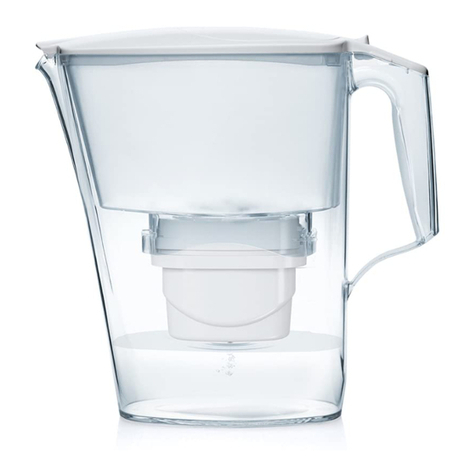
Strix
Strix Aqua Optima Liscia Instructions for use
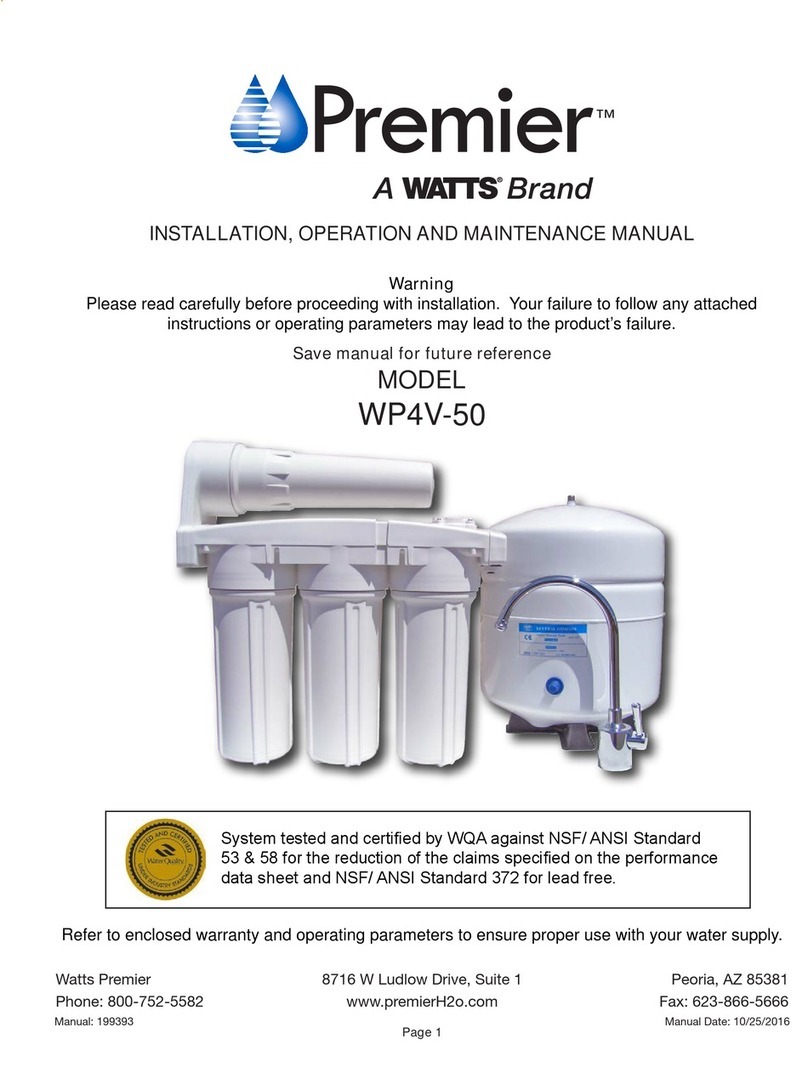
Watts
Watts Premier WP4V-50 Installation, operation and maintenance manual

Pentair
Pentair FRESHPOINT GRO-575M Installation and operation manual
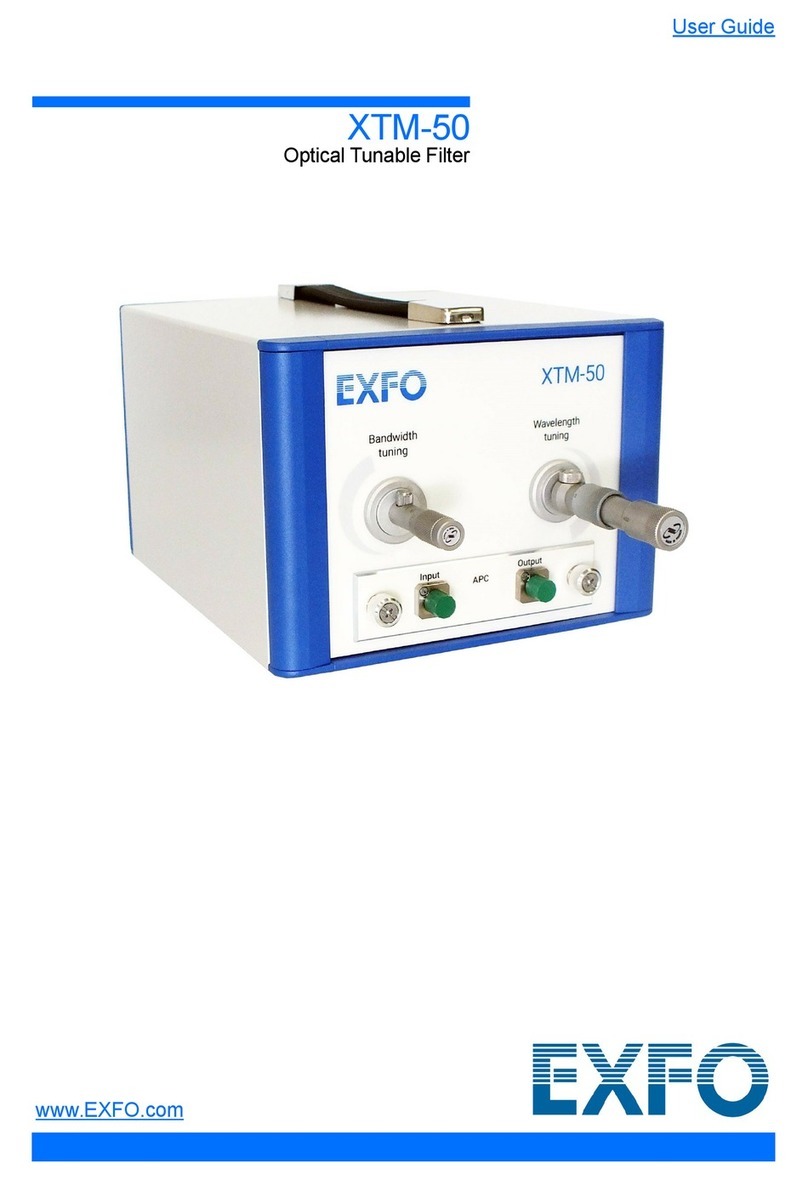
EXFO
EXFO XTM-50 Series user guide

Eureka Forbes
Eureka Forbes Aquaguard select AWS C2500 DX user manual
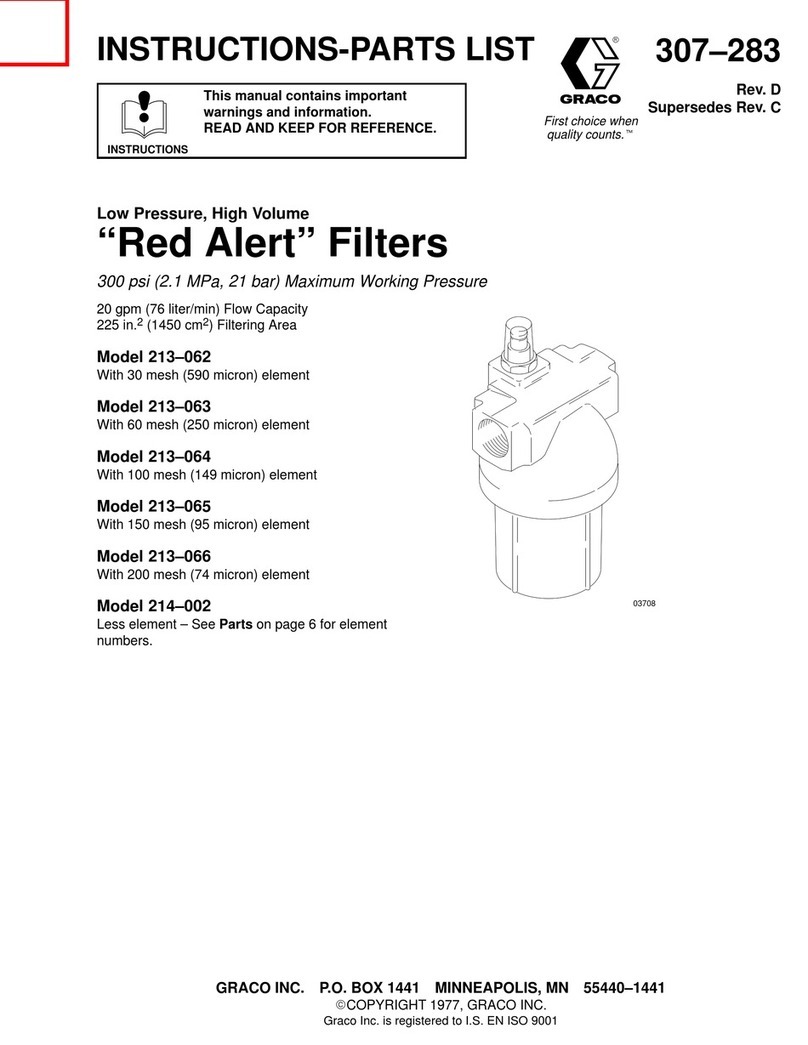
Graco
Graco 213-062 instructions
